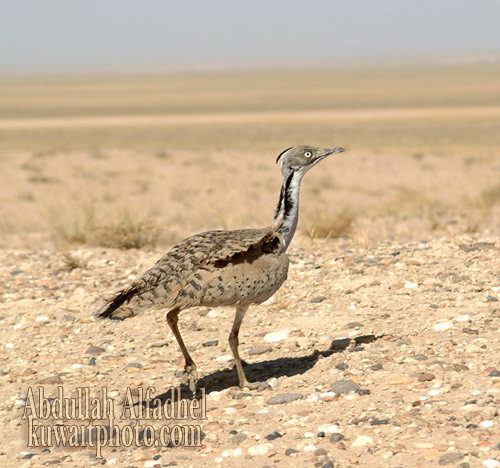| Line 7: | Line 7: | ||
====Vagrancy==== | ====Vagrancy==== | ||
MacQueen's Bustard has a greater tendency to wander than it's fellow ''Chlamydotis'' species, the sedentary Houbara Bustard. Records stretch as far as Great Britain, mainly in the 19th century, though only recorded as ''Chlamydotis'' bustards (pre-split, see Taxonomy). | MacQueen's Bustard has a greater tendency to wander than it's fellow ''Chlamydotis'' species, the sedentary Houbara Bustard. Records stretch as far as Great Britain, mainly in the 19th century, though only recorded as ''Chlamydotis'' bustards (pre-split, see Taxonomy). | ||
| + | ====Population==== | ||
| + | It is unlikely that any more of this species will reach western Europe, since it has been hunted to near-extinction in the Middle East by Arab falconers. Conservation efforts by the late Shaikh Zayed bin Sultan Al Nahyan in the United Arab Emirates have given some hope for the future of this bustard. | ||
==Taxonomy== | ==Taxonomy== | ||
*A monotypic species. | *A monotypic species. | ||
*Formerly lumped within [[Houbara Bustard]], ''C. undulata''. | *Formerly lumped within [[Houbara Bustard]], ''C. undulata''. | ||
| − | |||
==Habitat== | ==Habitat== | ||
Deserts and very arid sandy areas. | Deserts and very arid sandy areas. | ||
Revision as of 18:08, 15 July 2008
- Chlamydotis macqueenii
Identification
60 cm. Brown above, white below, black stripe down the sides of neck. Sexes are similar, but the female is smaller and greyer above.
Distribution
Nile Valley of Egypt to Arabian Peninsula and Pakistan.
Vagrancy
MacQueen's Bustard has a greater tendency to wander than it's fellow Chlamydotis species, the sedentary Houbara Bustard. Records stretch as far as Great Britain, mainly in the 19th century, though only recorded as Chlamydotis bustards (pre-split, see Taxonomy).
Population
It is unlikely that any more of this species will reach western Europe, since it has been hunted to near-extinction in the Middle East by Arab falconers. Conservation efforts by the late Shaikh Zayed bin Sultan Al Nahyan in the United Arab Emirates have given some hope for the future of this bustard.
Taxonomy
- A monotypic species.
- Formerly lumped within Houbara Bustard, C. undulata.
Habitat
Deserts and very arid sandy areas.
Behaviour
2-4 eggs are laid on the ground.
Diet includes seeds, insects and other small creatures.




